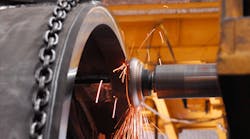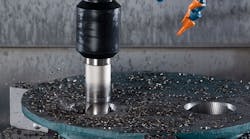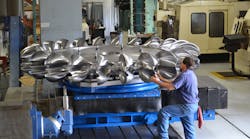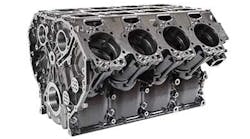Sudden edge failure may be the bane of machining processes, but it can also be an indicator of undiscovered problems — and a sign that will point you toward a better way to make that cut.
“Unless you are seeing gradual, predictable edge wear, you are looking at an opportunity for improvement,” explained Ingersoll Cutting Tools North American milling product manager Konrad Forman. “This holds true even when you are dealing with a loose machine, a high-strength alloy, a severe interrupted cut, or an extreme form cut: a long-reach operation, high-aspect holemaking, or an ID operation with limited clearance. With the newer insert and cutter geometries, and more accessible modified standard tools available today, there will always be a workaround.”
The examples demonstrating these conditions are widespread. Consider:
• With a simple retooling to bore a 0.25-inch diameter in a tiny medical part, MedFab Manufacturing Inc. in Lakeville, Minn., stabilized a slow, unstable operation so that it now runs unattended. After replacing a standard round-shank boring bar with a breakthrough microboring bar that features a husky, elliptical shank, though-the-tip-coolant delivery and free-cutting tip geometry, tool life increased from an unpredictable 5-20 pc to a reliable 250 pc — even at 15% higher metal removal rates (MRRs). The MedFab job is notable as the first commercial application for the Ingersoll T-Micro 250 boring bar.
• On a heavy, interrupted-cut rough milling operation, R.H. Sheppard in Hanover, Penn., eliminated tool wrecks resulting from spontaneous insert rupture by switching from radial to tangential milling cutters. Edge life rose from an unpredictable 60 pc to a reliable 152 pc, even at 30% to 40% higher MRRs.
• Just about every time on a long-reach finish-slotting job in hardened S-7 tool steel, River City Manufacturing and Machine Co. in Winona, Minn., encountered edge rupture less than 5 inches into the pass. The remedy: change to high-feed milling with a cutter that reduces the contact area and resulting lateral cutting forces. The Ingersoll Form-MasterV, specially designed for high-feed machining, improved edge life a reliable 4-to-1, and it reduced cycle time from 20 hours to four.
• In Ciudad Acuna, Mexico, off-road equipment OEM Terex ran into sudden, random edge failures and tool wrecks while rough milling big, boxlike weldments in hardened alloy steel. The existing radial cutter generated so much heat that the inserts glowed orange and ruptured catastrophically, and projecting chunks of carbide around the workplace. No inserts ever lasted through even one piece! Again, tangential milling, with its intrinsically stronger cutting geometry, brought everything under control, even on heavy interrupted cuts with a middle-aged “loose” machine. Now, the edges last through five complete parts, reliably, throughput has doubled, and all the hazards of shattered inserts and an overheated operation are a thing of the past.
“More often than not, insert rupture begins with the edge going dull, which raises cutting forces to the point of sudden breakdown — triggering a chain reaction,” according to Forman. “The other root-cause may be chatter, which ‘hammers’ the edge. The chain reaction happens so quickly, the sequence is easy to miss,” he emphasized.
Among the remedies he suggested are changing the presentation geometry to have the necessary cutting edge design, or substituting a different insert substrate to achieve either increased ductility or increased hardness. A third remedy is to shift machining parameters completely, toward higher feed rates and lighter cuts, and changing inserts accordingly. “Sometimes it is necessary to change all three,” Forman said. “The key is to keep experimenting until you achieve predictable edge wear.”
Perfect storm at MedFab
“Thin walls, a difficult long-chipping titanium alloy, long-reach ID machining, and tight finish specs added up to a machining ‘perfect storm’ for us,” said Shannon Morsching, MedFab manufacturing engineer.
Boring the tiny, thin-walled medical part confounded all previous attempts using a variety of conventional boring bars. Tools shattered unpredictably after as few as 20 pc, probably due to chatter, compounding the difficulty of machining titanium in the first place. Failures were so unpredictable that the term “average edge life” became meaningless. Even the completed “good parts” required 15 minutes of hand finishing to achieve the 16µ finish spec.
During a plant walk-through in early 2012, Ingersoll field rep Roger Piekarski suggested a novel T-Micro boring tool that was still in the pre commercial stage of development at the time. It is the only microboring tool to combine an elliptical shank, through-the-tip coolant delivery, and free-cutting edge presentation in one tool. The elliptical cross section enables a huskier shank while preserving a generous chip clearance channel.
The new tool has lasted through 250 pieces consistently, at 15% higher MRR, while delivering a 10µ as-machined finish. Sudden edge failure disappeared completely. “Finally, we have a stable process on a very challenging medical component,” Morsching said. “We replace the tool at 250 pieces just as a precaution and to preserve finish. The tool itself still looks good as new.”
Security over throughput
At R.H. Shepperd, the application involves rough milling the mating faces of cast iron housings for automotive transmissions, a high-volume job calling for an operation that inherently calls for interrupted cutting. Process security is paramount.
With the previous 6-inch radial facemill, one insert edge would rupture spontaneously, starting the chain reaction that led to irreparable damage to the cutter itself. The damaged insert doesn’t take off its share of material, which overloads the next insert to failure – all in a split second. To minimize stoppages, the machinists at Shepperd ran it 100% attended.
“The risk of such failures is one reason why we focused so hard on an optimal fix,” said Allen Smith, R.H. Shepperd manufacturing engineer. So, he sought ideas from all mainstream tooling suppliers and ran exhaustive trials. Finally, he settled on the tangential S-MAX facemill proposed by Ingersoll.
In tangential milling, the insert lies flat in the pitch circle, presenting its strongest cross-section to the main cutting force. Moreover, size for size the cutter body is stronger because less metal needs to be removed for the seat pockets. Also, inserts are larger and more robust than those in comparable radial cutters.
For Shepperd, edge life has increased four to one as a result of the retooling, and throughput is up 40%. “We’ve gone more than three years now without a single tool wreck or any production stoppage traceable to the tangential cutter,” Smith noted. “That said it all. The throughput savings were of course welcome, but more as a dividend. You can’t easily put a price on improved process security and fewer interruptions, but they are invaluable.”
Simple tip switch
Even on the first trial run on the hard-metal slotting job at River City Manufacturing and Machine, tool tips routinely fractured just five inches into the cut. At the time, the tool of choice was the shop’s mainstay, general-purpose mill: a conventional 1-inch Hi-PosQuad replaceable-tip tool (part of Ingersoll's Top-On family of modular tools.)
The diagnosis, after consultation with Ingersoll’s Ondrej Lubinski, was long-reach finish-milling, hardened stock (Rc 52) and extremely close tolerances all around. The long-reach aspect raises the risk that lateral cutting forces out at the end of a long extension can cause enough chatter to fracture the brittle carbide tip, or even the shank itself.
“Hardened feedstock simply compounded the problem,” Lubinski said. So, he suggested changing to a tip that would fit on the same shank yet reduce the cutting contact area: a Form-MasterV backdraft cutter.
Here is the takeaway: With the previous 1-in. Hi-PosQuad end mill, the parameters were 1,400 RPM, 18 IPM, 0.005-in. DOC. The part took 20 hours to complete and required at least one indexing stop due to sudden, unpredictable edge fracture. With the Form-MasterV backdraft cutter, the respective numbers are 2,600 RPM, 60 IPM, and 0.010 DOC, leading to a 4-hour cycle time. Most important, one tip lasts through two entire parts; the failure mechanism now is gradual, totally predictable edge wear.
“Faster feeds and reduced contact area between tool and workpiece will pay off, especially in hardened steel,” said Lubinski. “You’d be surprised at how quickly cutting forces rise with material hardness. The piece may look the same, hard or soft, but looks are very deceiving.”
Debottlenecking at Terex
The retooling at Terex began when the plant’s managers started a systematic search for ways to raise throughput, without capital investment. The search quickly centered on the big rough milling operation, since it had become such a bottleneck to the production process.
It is a big roughing job. The parts are transmission boxes, essentially huge tubes big enough to stand in – 9 or 12 ft diam., 8 to 10 feet long, with walls 4.5 to 8 in. thick. The bottleneck operation involves rough-milling about 0.700 in. of Rc32 alloy steel off both ends.
Previously, the process limped along using a conventional 6-inch radial facemill on an older, loose 40-HP horizontal milling machine, taking 3.5 hours to complete each part — and shattering inserts willy-nilly. The operation generated so much machining heat that it vaporized the cutting fluid into fumes, and made the cutter so hot to the touch that it took half an hour to cool off enough for an indexing.
Once again, the solution was to switch to tangential milling with an 8-inch tangential Ingersoll S-MAX facemill. As a result, throughput doubled, sudden insert failures disappeared completely, and tooling costs decreased 90%. “The inserts never suddenly rupture or crack anymore, they just wear out gradually now,” according to Roberto Magallanes, a Terex lead man.
As further proof of more efficient cutting action, the chips are hotter than before, yet the cutter and inserts are just warm to the touch. The heat of cutting is generated in the workpiece metal, to soften it at the cutting point, but then it leaves with the chips. Based on this success, Terex has standardized on tangential milling for all heavy roughing jobs.
“Edge rupture and tooling wrecks are always avoidable, even under the most adverse machining conditions,” Ingersoll’s Konrad Forman concluded, “and free help is available for the asking.”








